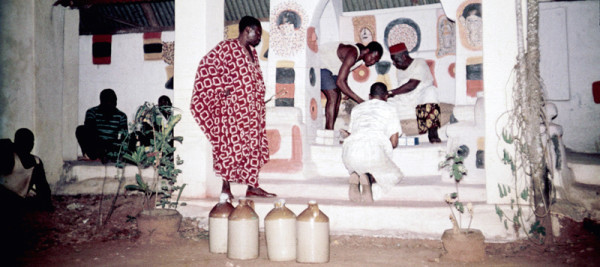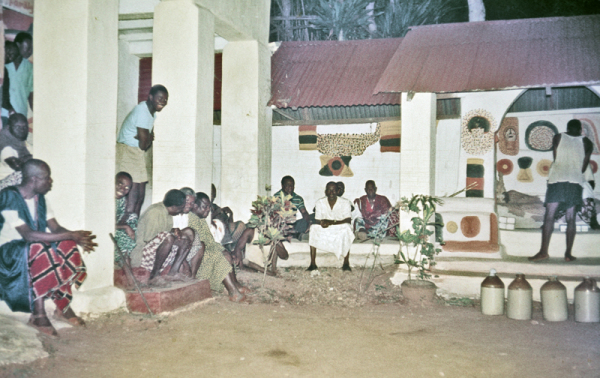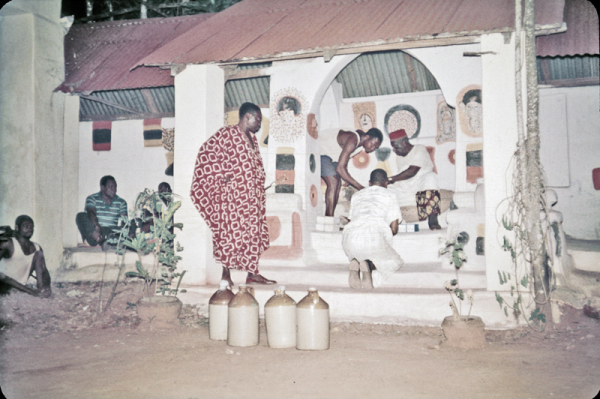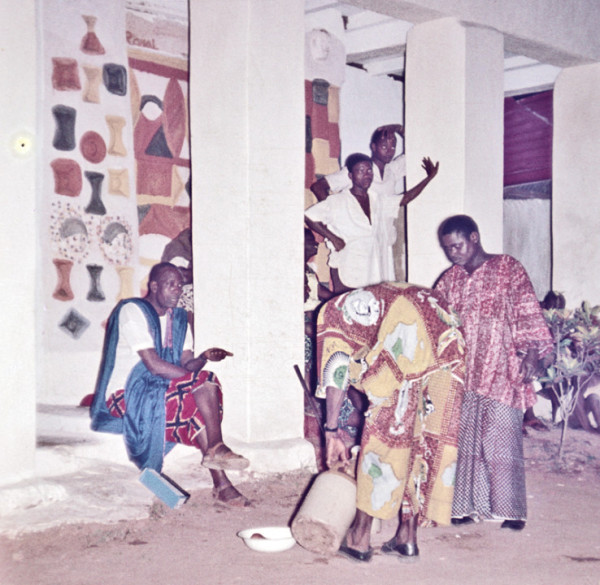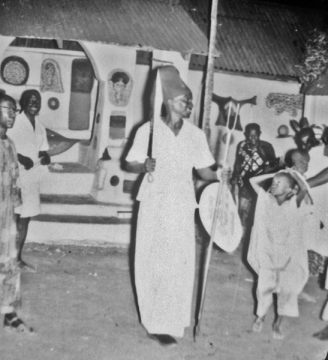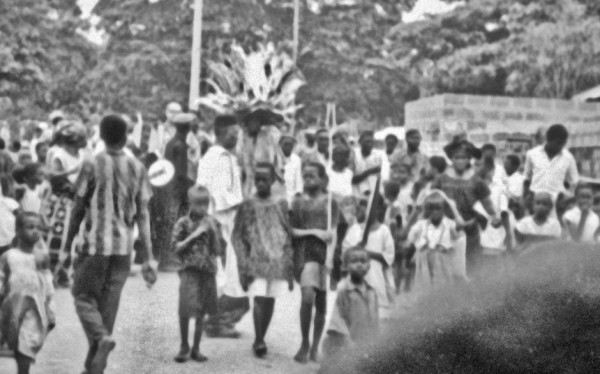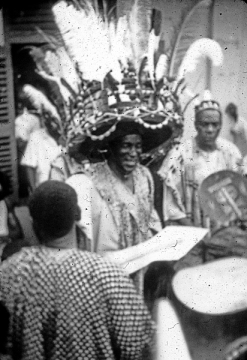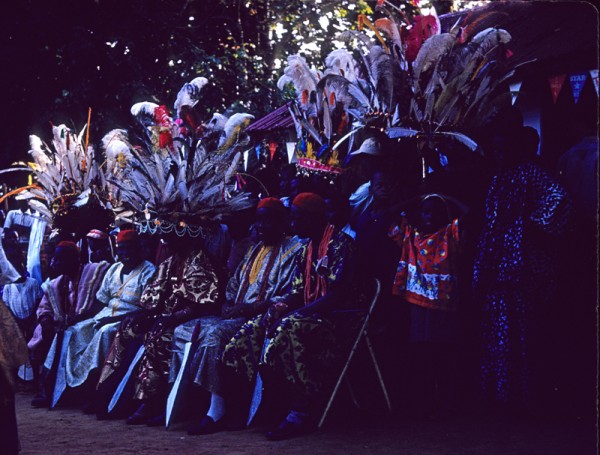[Note: Click on any image you may want to enlarge.]
1. Obi Okosi II in 1960
The decade of the 1950s was an eventful time for anyone actively involved in the affairs of Onitsha Town, but it surely was particularly challenging, indeed disorienting for the Obi of Onitsha (as for anyone actively involved in the complex sociopolitical affairs of the town but also becoming advanced in age ). During that period, he went from standing as a fairly significant decision-maker in urban affairs (Chairman of various successive town councils) to serving as a largely ceremonial “President” of such bodies, a token of the past (though he continued to draw a substantial salary and other financial perquisites, including entertainment funds), while the instruments of effective urban government changed several times during that decade to include more elected representatives and (to his chagrin) more non-Ndi-Onicha ones, until the latter obtained a majority in the new Onitsha Urban District Council of 1960 . 1
Moreover, his Standard-Six-Level education, which had satisfied local expectations when he took office in 1936, now seemed inadequate for anyone presuming to assert a role in the national affairs of the New Nigeria. And — in personal terms — he also lacked oratorical charisma. For example, in 1958, Obi Okosi II traveled to Lagos on a well-publicized visit to the Oba of Lagos, accompanied by his fellow Ndi-Onicha comrades, Prime Minister (Anatogu Onowu) and his legal advisor, Chuba Ikpeazu (an Onye-Onitsha lawyer who had already attained national prominence for his intellectual and legal accomplishments).
After photographs were taken at the Palace showing the two traditional leaders seated together on “the ancient Throne of Lagos”, His Highness Adenji Adele, Oba of Lagos, addressed Okosi II in welcome, then spoke at some length urging on all Obis and Obas in Nigeria to “remain neutral in politics”. In reply, not Okosi II but Mr. Ikpeazu rose to orate on behalf of the Obi, explaining that “by tradition, the Obi does not speak openly in public.” 2 While Mr. Ikpeazu’s address eloquently praised the new friendship, which “would further the building of a great Nigeria capable of taking her right place in the world”, newspaper reports of this event focused on the fact of the Obi-Onicha‘s silence, which greatly embarrassed educated Ndi-Onicha (who were well aware that their Obi “has no tongue”, that is he was incapable of public speaking with any degree of fluency).
However, on the level of regional government, the prospect that the Eastern Region would now move to establish a House of Chiefs considerably increased the Obi‘s importance in some ways, since substantial “Chiefs” were extremely scarce in most of Igbo-land east of the Niger, and yet such figures now became in demand. Obi Okosi II seemed a sure bet to become a “First-Class Chief”, and possibly some of his Onicha Senior Chiefs (Ndichie-Ume) as well, while many nearby communities lacked traditional leaders with any comparable stature. Consequently, the leaders of traditional Enu-Onicha became important brokers of access to the methods and means of asserting “Obi-ship”. Neophyte “Kings” of Igbo-land such as the Obi of Awka-Etiti, below, needed guidance for building their traditions of “rulership”, which.both Onitsha chiefs and their lawyers were quite ready to provide (for a fee).
Moreover, within Enu-Onicha itself, old chiefs were dying and younger, more Western-educated men now evinced interest in replacing them. Since selection and installation of new chiefs always brings considerable wealth to both the Obi and the members of his cabinets, this promised additional income for these traditional leadership positions.
Between 1955 and 1960, five of the six Senior Chiefs (Ndichie-Ume) of Onitsha were replaced after their demise (in one case, the title became vacant twice), and Obi Okosi had the lucrative if often controversial task of selecting and installing their successors. Onowu Obinwe of Umu-Dei died in November 1955, and Okosi replaced him with Philip Anatogu of Umu-Ase, thus confirming the resolution of a debilitating 7-year split within the non-royal villages of Enu-Onicha. In December 1955, A.I. Mbanefo succeeded his father as Odu (Third Minister). R.D. Adibuah of Ogbeozala became the new Onya (Fourth Minister) in 1955, but died in January 1960 (and was succeeded by Simon Egbunike of Ogbe-Ndida later that year). Egbuna the Ajie (Second Minister) also died in January 1960 and was replaced by Mbamali of Ogboli-Olosi later in the year. And in June, Obianwu the Owelle (Sixth Minister) died. 3
So it happens that in our first encounters with Onitsha kingship, Helen and I are allowed to witness the installing of H.O. Orefo of Ogbe-Otu into his new title as the Owelle of Onitsha. The first steps of his ascendance have already been taken, from the initial acts of informal gift-giving inquiries to members of the royal family and Senior Chiefs, to a ritual formal acceptance at the Palace, where the candidate offers a goat for sacrifice (Igbunye ewu na-ime Obi), and receives the first item of regalia identifying his position as a Senior Chief: the Azuzu. a large leather fan indicating his future role in peacemaking.
So when we first meet him, we already salute him by his title-name, Owelle. Following this, he must pay his full title fees (estimated in 1960 to be somewhere around £700-800), distributed between the Obi and all his chiefs (each grade receiving a proportion according to its rank). The Owelle-elect then visits each of his five fellow Ndichie-Ume and offers each a goat, palm wine, a bottle of Schiedam’s Schnapps, and other goods, in a ritual called Igo-mmuo (“Begging the dead”). He is then ready for the final installation.
2. Owelle title-taking at Ime-Obi
On the eve of the final steps of his installation, we arrive at the palace at dusk, finding the Owelle-elect already there, waiting outside. He is wearing white dress and carrying his large fan. We are informed that several Ndi-Onicha barristers (including Luke Emejulu and Alex Mbanefo) have already gone upstairs to greet the Obi in his private chambers. When the Onowu arrives he goes up there also, to join them in greeting the Obi. Meanwhile we receive a brief tour of the three courtyards of the palace, on the basis of which I make this drawing, which includes appropriate seating arrangements.
 My error here is to place the Prime Minister (marked as “PM”),the Onowu, the first among the six Senior Chiefs; Owelle will be no. 6) on the side of the entry stairway to the upper floor of the palace next to the “Okpalas” (Di-Okpala, senior patrilineage priests of Onitsha). His position is a further distance away from the Obi, along with the other 5 “first-class chiefs” (Ndichie) as I label them here, closest to the stairway leading to the upper chambers but on the far side of the stairs. The stairway itself is occupied by any and all members of the royal lineage who care to be present, and who form a protective phalanx for the Obi when he enters or exits the court. (The Obi‘s need for protection is a constant theme.) Below you see the Onowu seated at far left, beyond the near pillar, while an array of royal men of varying ages occupy the stairs. The Throne (Ukpo-Eze) is at right, with Obi Okosi II seated on it, obscured by a servant. Eight gallons of palm wine are contained in the jugs set before the throne.
My error here is to place the Prime Minister (marked as “PM”),the Onowu, the first among the six Senior Chiefs; Owelle will be no. 6) on the side of the entry stairway to the upper floor of the palace next to the “Okpalas” (Di-Okpala, senior patrilineage priests of Onitsha). His position is a further distance away from the Obi, along with the other 5 “first-class chiefs” (Ndichie) as I label them here, closest to the stairway leading to the upper chambers but on the far side of the stairs. The stairway itself is occupied by any and all members of the royal lineage who care to be present, and who form a protective phalanx for the Obi when he enters or exits the court. (The Obi‘s need for protection is a constant theme.) Below you see the Onowu seated at far left, beyond the near pillar, while an array of royal men of varying ages occupy the stairs. The Throne (Ukpo-Eze) is at right, with Obi Okosi II seated on it, obscured by a servant. Eight gallons of palm wine are contained in the jugs set before the throne.
 At right, the candidate for the Owelle title, H.O. Orefo, sits to the right of the Obi in the place reserved for the Senior Lineage Priests of Onitsha. (This is the last time he will ever sit there.) Behind him are three men in this position, including Nnanyelugo Ibekwe of Odoje (whose wife is one of the Obi‘s daughters), Akunnia Offiah of Umu-Asele,and Akunne Ediboss of Ogbe-Ozala. The presence of these descent-linked representatives from other villages, and who are regarded as “senior” to the Obi, is essential for validating any meeting of this kind. Note also the figure of a man sitting on the ground near the stairway , his face concealed behind a shrub, and whose legs are withered. This man plays a joker’s role throughout the ritual from his sitting position, producing considerable laughter. (I am told he is a sibling of the Obi who often plays this role during events in the palace.)
At right, the candidate for the Owelle title, H.O. Orefo, sits to the right of the Obi in the place reserved for the Senior Lineage Priests of Onitsha. (This is the last time he will ever sit there.) Behind him are three men in this position, including Nnanyelugo Ibekwe of Odoje (whose wife is one of the Obi‘s daughters), Akunnia Offiah of Umu-Asele,and Akunne Ediboss of Ogbe-Ozala. The presence of these descent-linked representatives from other villages, and who are regarded as “senior” to the Obi, is essential for validating any meeting of this kind. Note also the figure of a man sitting on the ground near the stairway , his face concealed behind a shrub, and whose legs are withered. This man plays a joker’s role throughout the ritual from his sitting position, producing considerable laughter. (I am told he is a sibling of the Obi who often plays this role during events in the palace.)
Ononenyi Gbasiuzo Okosi, the Obi‘s immediately senior lineage priest, arrives and escorts the Owelle-elect upstairs to administer a secret oath for him to swear. He then sits as shown above and the Obi enters the courtyard, as all stand, all heads bare except his (he wears his red cap). There follows a series of salutes to the Obi, beginning with the Onowu as the most senior of the senior chiefs present. Onowu stands facing the Obi, makes a series of movements while saying, “Igwe” (“Sky”) each time: right foot and right hand forward, then left foot and left hand, repeated, then right foot forward while swinging both arms low from left to right, then the reverse, repeated four times, then he squats, touching his head with his right hand and saying, “Igwe“. These latter movements I am told represent the senior chiefs serving as the Obi‘s Oarsmen (a remarkable procedure since INdi-Onicha are not strongly depicted as boatmen). Lower-ranking chiefs do simplified and truncated versions of this salute, then bow down and touch their heads on the earth, and all others simply do the bowing and verbal salute.
Orefo’s relatives place before the Obi the various goods presented to him: Kola nuts, 4 jugs (8 gallons) of Palm Wine, 4 bottles of Siedham’s Schnapps, (and they have emplaced nearby the regalia for the Owelle‘s chieftancy). the Owelle-elect kneels before the Obi, salutes him as “Igwe“, and says, these are the Kola I have brought you. The Obi takes a kola nut, breaks it, and hands a piece directly to Orefo. This contravenes standard practice: ordinarily, the Obi‘s hand does not touch another’s. At this moment, a mutual identification is affirmed.
Then the Obi calls one of his servants, who holds his two hands palms up together, and Obi drops a kola nut into these hands, and the servant then carries it to the most senior chief (here, the Onowu), repeating this step to all other senior chiefs present. Then he takes pieces to the lesser chiefs in order of preference, dropping the nut with his right hand into each one’s cupped palms, and this is repeated for all others present. Everyone present eventually receives a piece of kola, which each person is required to consume (indicating one’s fidelity to the standards of truthfulness that kola “contains”).
Then, below, the Obi holds a cupful of palm wine, prays over it for the Owelle-elect’s long life and prosperity, than hands it to him. The Obi then rises (all others stand up also) and departs from the courtyard, accompanied by servants who carry two of the jugs of palm wine and two of the bottles of schnapps with him up the royal stairs. He must not remain in the presence of people drinking, where emotions endangering him might erupt. The Owelle squats to drink his wine, supervised by the King’s elder brother Ononenyi Gbasiuzo Okosi (standing at left).
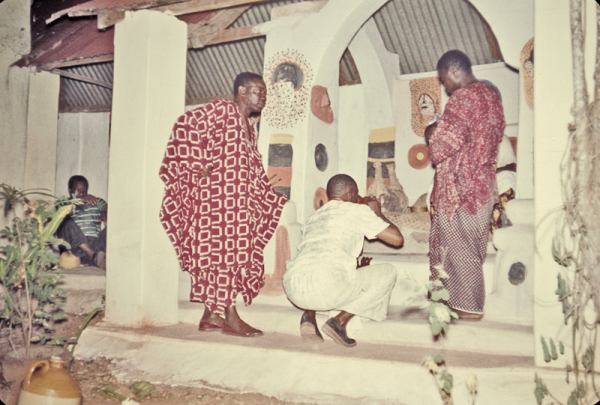 Note below the painted sculptures in bas-relief flanking the throne. The four flanking faces represent the Obi‘s Naked Slaves (Mgbaloto Eze), figures from the past, each covered over with leopard-spots indicating their identification with the Obi. The circular figure behind his head depicts a coiled python (agbu-ani, lit. “rope-snake”), it too covered with the leopard-spots indicating Kingship. (The leopard (agu) is King of the forest, while the Obi rules the town (Obodo). When a man of the town kills a leopard in the bush, the animal’s carcass must be presented to the Obi, whose diviners ensure that it was not the Obi himself who has been killed. The python is an animal “who waits for its prey to come to him.” 4
Note below the painted sculptures in bas-relief flanking the throne. The four flanking faces represent the Obi‘s Naked Slaves (Mgbaloto Eze), figures from the past, each covered over with leopard-spots indicating their identification with the Obi. The circular figure behind his head depicts a coiled python (agbu-ani, lit. “rope-snake”), it too covered with the leopard-spots indicating Kingship. (The leopard (agu) is King of the forest, while the Obi rules the town (Obodo). When a man of the town kills a leopard in the bush, the animal’s carcass must be presented to the Obi, whose diviners ensure that it was not the Obi himself who has been killed. The python is an animal “who waits for its prey to come to him.” 4
With the Obi now absent, the Onowu (below) takes charge of distributing the palm wine, now assisted by relatives of the Owelle-elect. He calls whoever he likes among his dependents to come and drink, each person kneeling before him on the right knee, left arm on the left upright knee, and takes the drink in his right hand, saying “Onowu“. After the Prime Minister is satisfied, he allows others to call their dependents to drink, first other senior chiefs, then lesser chiefs, then the Di-Okpalas.
The Onowu keeps one jug of the palm wine for himself (and for other Ndichie-Ume), and does this also with one bottle of Schnapps (this is served out in the same fashion as was just done with the palm wine). A potentially amusing moment in the process occurs on this occasion, when Akunne Ediboss, one of the Diokpalas present, calls Barrister Luke Emejulu (who has just descended from his private meeting upstairs with the Obi and intends to depart from the courtyard scene without participating in it) to come and take a drink from him. The joke is that while Mr. Emejulu may be a man of considerable national importance (he has been active in, and is well-known for his recent Lagos politics), he has not taken the Ozo title (which is a requisite for an Onitsha man to act as a priest). Ediboss in contrast is a marginally-employed person but holds the Ozo title, therefore (since they are both members of Umu-EzeAroli, a royal subclan) he has the right to call this untitled person to kneel before him as his dependent and salute him with his titled name (in this case, Akunne [“Mother’s Wealth”]). This would be deeply embarrassing to Mr. Emejulu. Fortunately for him, the Onowu is alert to the situation and dissuades Ediboss from his intention. (Ediboss is notorious for his comedic antics.) 5
In the final phase of the ritual, the Obi returns to his throne, and the Owelle-elect again kneels before him and his relatives present to the Obi the final major set of his regalia, which include his Okpu Ododo (red cap), the Abani (his warrior’s sword, a double-edged blade of iron, colored black and white), the Ogbanchi (his brass spear-staff), his Akposi (a leather bag for carrying his chief’s Ofo and other medicines); and his Mgbilimgba, a metal bell. This bell is attached to the Akposi, which has a leather head-loop so it may be worn by a pre-pubertal boy who carries it before the Owelle whenever he leaves his house (the jingling bell warns ordinary folk, and the ghosts of those he may have killed, to flee at his approach). Carriers of corpses must conceal their burdens from his gaze, since he will henceforth not view any corpse). At right above, the Obi examines the Ogbanchi presented to him by the Owelle‘s relatives. The Owelle-elect must pay for each of these items as the Obi accepts them and then hands them to the new chief.
Now (the Obi has again departed for his private chambers), the new Owelle stands forth holding his Abani (painted vertically in black and white) in his right hand, his Ogbanchi spear-stff and Azuzu fan in his left, while his small (pre-pubertal) boy (at lower right) holds the Akposi with its attached Warning Bell by the strap provided. Gun shots are fired into the night, as the Owelle performs his Senior Chief’s dance, while his relatives sing his praises.
3. Owelle’s “Outing”; Meanings of “War Dancing”
On the following day, each of the five incumbent Senior Chiefs gathers the members of his major village, and together they dance their way across the town to the village of their new member, the Owelle (who now controls the village of Ogbe-Olu). Each group forms a compact mass of people, led by their particular senior chief and his fellow chiefs, titled men, and commoners. The Senior Chief wears a massive, feathered Crown (Nnukwu-Okpu, “Great Crown”) symbolizing this community as microcosm. Below, the major village of Odoje enters Ogbe-Olu, led by their Ndichie-Ume leader, Odu Mbanefo II. As he arrives, the people clear the way for him to dance. (Note to his right, a supporter fans him with his own chieftain’s fan (Azuzu), while at near right in the photograph his young boy stands holding his Akposi (the leather Ofo-containing bag carried behind his back, with its warning bell attached), and waits to observe his performance.
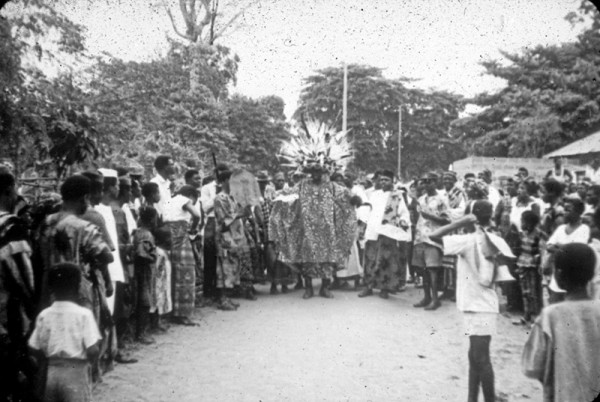 When the Onowu appears, leading members of his Umu-Asele-Iyawu Village, he too is preceded (below) by an array of boys from his family, each carrying an item of his regalia. The boy in the center holds upright the two-pronged Ogbanchi spear-staff, while immediately to his left a younger one carries the black-white Abani sword.
When the Onowu appears, leading members of his Umu-Asele-Iyawu Village, he too is preceded (below) by an array of boys from his family, each carrying an item of his regalia. The boy in the center holds upright the two-pronged Ogbanchi spear-staff, while immediately to his left a younger one carries the black-white Abani sword.

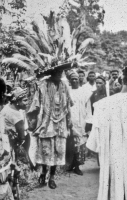 Each of these Ndichie-Ume does his dance in his own way. At first he dances to the Abia-ulo durm of his own group; then to the royal war drums. The Odu at left, holding his Otinri (horsetail whisk representing death and mourning) in his left hand, brandishing his Abani toward the crowd with his right, performs the circling and counter-circling movements in the more traditional way, while the Onowu at right (known for his peculiar versions of dancing) makes fierce faces, and lunges toward the crowds in a comical way, making a kind of parody of the dance, which is done to sounds of the official war drums. In this instance, the Ozi (a metallic double gong intensifying war-sounds) is that of the king since the Owelle does not yet have his own. Each Ndichie-Ume is accorded his own distinctive tune in the war-drums. (Tomorrow the Owelle will go to the palace to obtain his own instrument.)
Each of these Ndichie-Ume does his dance in his own way. At first he dances to the Abia-ulo durm of his own group; then to the royal war drums. The Odu at left, holding his Otinri (horsetail whisk representing death and mourning) in his left hand, brandishing his Abani toward the crowd with his right, performs the circling and counter-circling movements in the more traditional way, while the Onowu at right (known for his peculiar versions of dancing) makes fierce faces, and lunges toward the crowds in a comical way, making a kind of parody of the dance, which is done to sounds of the official war drums. In this instance, the Ozi (a metallic double gong intensifying war-sounds) is that of the king since the Owelle does not yet have his own. Each Ndichie-Ume is accorded his own distinctive tune in the war-drums. (Tomorrow the Owelle will go to the palace to obtain his own instrument.)
Below, the Ogbe-Olu village orchestra is performing. The man with the cap seated just left of center is playing the Ozi double gong, while the very long narrow drum played by the man in the foreground is the Village Abia-Ulo, which makes a very deep sound, nearly more felt than heard. The men sing, “Obi, emeka; Igwe, emeka;” “The Obi has done well!”

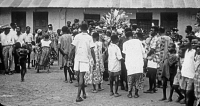
 As each chief completes his dance, he is escorted to the Owelle‘s Iba (Ancestral House), where his Great Tree Headdress is removed (as at left) and he goes inside to receive refreshments. At right, the Owelle‘s wife, dressed in finery, dances in celebration (accompanied by other women associated with the village). The women sing, “Owelle echie; onyemelu ife, ogene ka omeˆ“, which means “Owelle rules; whoever wants to do something, knows what to do” (the implication being that anyone overcome with jealousy toward his achievement may commit suicide).
As each chief completes his dance, he is escorted to the Owelle‘s Iba (Ancestral House), where his Great Tree Headdress is removed (as at left) and he goes inside to receive refreshments. At right, the Owelle‘s wife, dressed in finery, dances in celebration (accompanied by other women associated with the village). The women sing, “Owelle echie; onyemelu ife, ogene ka omeˆ“, which means “Owelle rules; whoever wants to do something, knows what to do” (the implication being that anyone overcome with jealousy toward his achievement may commit suicide).
In the climax of this celebration, the Owelle himself appears, wearing for the first time his own version of the Great Tree Headdress, brandishing his own brass Abani (the black-white one he carries when entering the presence of the Obi). As you see here, some Senior Chiefs wear broadly smiling faces on these occasions, suggesting tones of dramatic delight and even camaraderie, though the “war drums” (Otu-Ogene) to which they dance beat out their fast rhythms in harshly clanging tones and definitely intend to convey the intensity of combat. So my earliest visual and auralimpressions sense the congenial, aesthetic pleasures of their dancing and their associated regalia, the theatrical pleasure of the accompanying villagers, and little more.
The Great Crowns of these chiefs are emulations of the even greater one worn by the Obi, and their significance for Ndi-Onicha can hardly be exaggerated. Their size, their potent visual impact overwhelms that of the weapons of violence also carried by the Obi and/or his Ndichie Ume when they appear in public ceremonies. And their structure and decoration connects them to the dominant symbols or root metaphors of Ndi-Onicha culture in such a way that knowledgeable participants in these rituals are able to experience that culture’s reality as a whole. What these great tableaux symbolize is no less than the comprehensive unity of those wearing them (and those participating as followers in support) with their total (local-to-cosmological) context.
My first experience of chiefs’ dancing (more particularly the Ndichie Ume, the “Senior Chiefs” of Onitsha) impresses me primarily with the way all of the performers respond to the obvious presence of photographers by freezing into fixed poses, especially when moving in clustered groups. These are very much theatrical displays. At the same time, they are religious statements of realities worth defending. We have described and interpreted the various forms comprising this religious complex (associated with the Ijele masquerade) elsewhere6, but a few additional words seem relevant here.
4. Great Crowns and Ghostly Ones
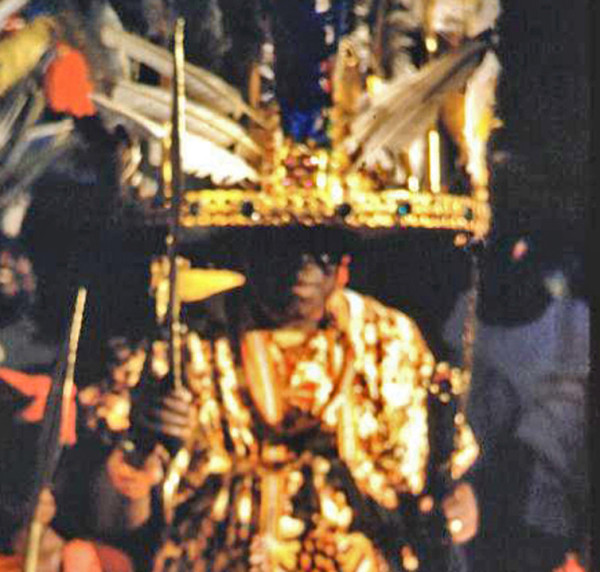
Throughout West Africa, traditional forms of leadership have long been rooted in religions that postulate an intimate association between the lives of humans and the life of nature, and affirm moreover that human beings can increase their control of natural forces and ensure prosperity by installing selected individuals into leadership positions featuring close relationships with those aspects of nature that the people identify as crucial. Ritual programs in which these leaders demonstrate both identification with and control over these natural forces in performances of various kinds. In Onitsha in 1960, for example, every Onye-Onicha knew enough to hail the Obi as Igwe, which means “sky,” but far fewer knew his salutation as Mkpu, which means “termite mound.” These two terms of reference reflect the basic polar dualism of the Onitsha king’s identity: depths of earth and height of overarching firmament. (And the Earth, Ani, is the domain of hallowed ancestors.)7
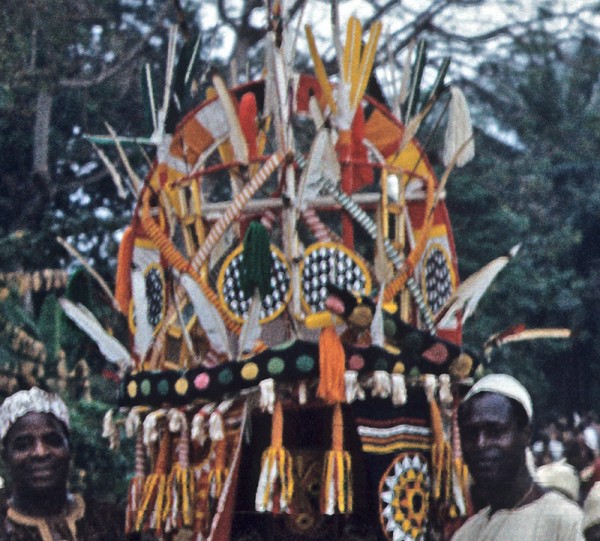
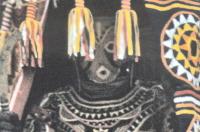 This Ijele figure, escorted by members of the Ota Age-grade (Ogbo), wears a Crown that is homologous to those worn by the Obi or his chiefs (Ndichie). The prime difference is the masked figure, whose face is barely discernible behind the paired tassles. This is an ancestral, ghostly chiefly person (Onye-Mmuo, one of the dead), who has come out from the Land of the Dead (Ani-Mmuo) to inspect and measure the living.
This Ijele figure, escorted by members of the Ota Age-grade (Ogbo), wears a Crown that is homologous to those worn by the Obi or his chiefs (Ndichie). The prime difference is the masked figure, whose face is barely discernible behind the paired tassles. This is an ancestral, ghostly chiefly person (Onye-Mmuo, one of the dead), who has come out from the Land of the Dead (Ani-Mmuo) to inspect and measure the living.
Starting visually from the top, clustered feathers and intimations of branching on these spectacular crowns suggest birds perching on a tree, and therefore a tree itself, an implication made quite explicit in the Onitsha people’s prime metaphors for leadership: the leader is a “mighty tree,” oke osisi (the latter is a general term accommodating diverse types of trees and pieces thereof), that gives birds perching on its outstretched arms and shoulders a safe abode. One part of the dominant symbol of these headdresses is a tree of this kind, together with its perching birds (and other exalted beings).
Starting from the base, the chief’s head resides in a small dome exaggerated on the platform above to form a mound (this one is beige in color), out of which rises a central pillar that (in one dimension of meaning) designates the trunk of the tree. Vertical arches and horizontal loops are then attached to complete the overall framework. Around the periphery of the flat disk base, coiled decorations indicate an encircling snake, the python (Agwo-ola), denizen of rivers and sacred messenger of mother earth (Ani).
Symbolically, then, the chief’s head lies under a mound of earth, but this is distinctly a termite mound (mkpu), home not only of the insects who built it but also the dens and perches of various snakes and other reptiles, birds, and mammals, and full of holes that constitute pathways to the human ancestors of the community who are buried there and now reside there.((Significantly, what a western entomologist would call the “Queen” termite of a termite mound (she is the sole, prolific source of an astounding reproductive fertility, iconic in Igbo eyes) is in Igbo called Obi, i.e. “King”.8 Compare Paula Ben-Amos on indigenous termite-ology in Benin: according to Ben-Amos (personal communication), the Bini say that each morning, the soldier termites carry the “king” (Oba) of the termites to the very top of the mound, where he performs a ritual to open the day. Ben-Amos (1980:45) writes suggestively on the probably ancient cultural connections of Benin with Igboland, reflected in a Bini origin myth.
Out of this mound (a complex symbol of fertility) grows a mighty tree, on the branches of which perch birds of rivers, fields, and bush, secure and exalted in their elevated fold. In the lower portions, various small earth creatures clamber about and valuable things lie around the base, the whole encircled by a snake. These crowns represent in summary a generalized conception, a “tree of life” (including various supporters of life). The great tree is also depicted in folktales as a protector, giving shade, shelter, and refuge. The tree is a provider of essential utilities for living, especially food, but also medicines, fuel for fires, and of course widely diverse building materials. It is, moreover, a living being, whose parts may be seen to correspond with human morphologies (including among other things phallic extension and hollows, implying both male and female). It has in addition the remarkable capacity to wither and then regenerate by seasons, and even the power, after dying or being cut down, to regenerate life out of roots or even branching parts.
Trees are also associated with the resolution of disputes and with persuasive powers of speech. They are of course greatly valued for their shade, considerably cooling the space beneath, and Ndi-Igbo and Ndi-Onicha associate coolness with dispute resolution and social calm. Great trees are locales where conflicts are most readily resolved and decisions rendered.
So in a wide variety of ways, these crowns comprise complex symbols of social unity and sustainability. Here below, the major chiefs of Onitsha sit together, their Great Crowns (each one associated with a particular Onitsha village or sub-village) held above and behind them by their attendants, sit awaiting the climactic moment of Obi Okosi’s Emergence from his Palace in October of 1960.
5. Obi Okosi II Ofala for 1958
Obi Okosi II’s Ofala for 1958 was nicely described in Nigeria Magazine by the Onye-Onicha writer, Onuora Nzekwu, who tells (with many fine images) how the Festival forms the great climax of the traditional year, when the Obi first enters a retreat from his everyday realm, and “performs acts of purification on behalf of his subjects and himself9. Ndi Onicha call this “Eze enters into Dreaming” (inye-ukwu-na-nlo-Eze): 10
“clothed as a mourner (wearing only a loin cloth) and covered with white (clay), he retires into his house of breezes (Uno-ifufe). There, on each side of his throne, fires are kept burning; for the only time during the entire year, the king behaves like a senior patrilineage priest, sitting beside a fire to fast and mourn for all his people who have died during the year. He also communes with the great god (Chi-Ukwu, associated with the sky), with the land (Ani-Onicha, the Mother Earth of Onitsha), with other great spirits (Alusi), and with the ghosts of former kings.”.
As Nzekwu puts it, “In keeping with his role as a ‘divine’ king and a the sacred repositor of his people’s prosperity the Obi devotes those days … trying to bring the forces of nature under control so as to ensure his people’s welfare11. The ritual cycle here is intermeshed with the Onitsha “New Yam Festival” (Owuwaji), which revolves around the story that12
“…when yams were first brought into Onitsha, all the people were afraid to eat them, for fear that the strange tubers might be poisonous. The king called upon his special doctors… to provide a medicine that could be smeared over the yams to make them safe for eating… (and) directed the doctors to supervise the initial eating (to be done by various social units in a sequence, ending with the Obi eating the yams)….”
So an annual time of harvest, with the arrival of plenty, is preceded by a stepped series of actions specifying anxiety, fear, requiring mourning, the need for self-purification, cleansing. But when the sequence nears completion, and the harvest appears fruitful, the king may now emerge from his seclusion.
Nzekwu describes how the Obi appears before his assembled chiefs, receives the cheers of his people, and then moves three times around the Palace Square, “Attended by a train of Ndichie, Ozo titled men and his relations”, first going one-third of the way (saluting certain sacred shrines) before dancing to the Royal Drums, then retiring to his “Breeze-House” (Uno-ifufe), where he receives salutes from the Ndichies in their order of seniority. then he goes two-thirds of the way in a similar fashion, and finally completes his counterclockwise circuit before a final retiring. On this final circuit, he is accompanied by his chiefs also wearing their own Great Crowns.13
So these Festivals of various kinds, with their dances expressing comprehensive unification of (1) Onitsha as a whole and (2) its distinctive villages, symbolize a high attainment of village, community, and environmental solidarity. And yet, we soon learn, from those Ndi-Onicha who, from the traditional perspective, “know something” about Enu-Onicha life, that at any public occasions where chiefs dance, they are doing much more than would appear to casual, uninformed observers. Although chiefs and King are in one aspect formally defined as peace-makers within and between Onitsha villages (and I assume in the early days of our research that I will have opportunity to observe their performances in this domain), the main narratives I hear concerning chieftaincy and kingship emphasize how specific chiefs and the King as well have, at recent rites of Emergence, waved their Ceremonial Swords at certain moments while dancing and, by doing so, struck deadly (if delayed in effect and invisible to the naive eye) blows into their opponents by acts of 
 sorcery (“hitting with poison” (iko nsi)). This process is said to occur at all such public concentrations, whatever expressions of “social solidarity” might be openly apparent. For example, Egbunike the Onya appears dancing, at left, into the arena of Obi Okosi’s 1960 Ofala festival, and at right in 1961 at the Iba of Igwe Enwezor. On both occasions he displays his Azuzu fan of peace, but some of those who “know something” assume that his fan (or his ceremonial sword, his horsetail switch, etc) is armed with various hidden weapons.14 All Ndichie in Onitsha, and preeminently the Ndichie-Ume, are encircled within a shadow of violence in this sense. And this is true of lesser chiefs and Ozo-titled men as well.
sorcery (“hitting with poison” (iko nsi)). This process is said to occur at all such public concentrations, whatever expressions of “social solidarity” might be openly apparent. For example, Egbunike the Onya appears dancing, at left, into the arena of Obi Okosi’s 1960 Ofala festival, and at right in 1961 at the Iba of Igwe Enwezor. On both occasions he displays his Azuzu fan of peace, but some of those who “know something” assume that his fan (or his ceremonial sword, his horsetail switch, etc) is armed with various hidden weapons.14 All Ndichie in Onitsha, and preeminently the Ndichie-Ume, are encircled within a shadow of violence in this sense. And this is true of lesser chiefs and Ozo-titled men as well.
6. The episode of the bleating heart
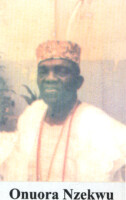 While I have discussed this subject elsewhere, the scope, range, and sociocultural importance of such “traditional” activities during the early 1960s is nowhere better limned than a fictional event described in a remarkably vivid novel of that time, “Wand of noble wood“, written by Onuora Nzekwu (an eminent Nigerian journalist and an Onitsha man), whose tale about Ndi-Onicha (those who trace their origins to what he calls “Ado“) is set in the Nigeria of 1959. Call it The episode of the “bleating heart”.
While I have discussed this subject elsewhere, the scope, range, and sociocultural importance of such “traditional” activities during the early 1960s is nowhere better limned than a fictional event described in a remarkably vivid novel of that time, “Wand of noble wood“, written by Onuora Nzekwu (an eminent Nigerian journalist and an Onitsha man), whose tale about Ndi-Onicha (those who trace their origins to what he calls “Ado“) is set in the Nigeria of 1959. Call it The episode of the “bleating heart”.
***********
Peter, the first-person protagonist of the novel, is (like Nzekwu himself at the time) a journalist working for a national magazine and living in Lagos. A “real Onitsha man” (that is an indigene, native of the Inland Town), Peter listens frequently to his internalized voice of a deceased respected elder who repeatedly reminds him of appropriate traditional perspectives and behavior.
Inquiring from associates about the recent ill health of another Onitsha man named Mr. Agbata, “a kind, elderly gentleman with whom I had made friends”, he learns that the old man has now become seriously ill and is calling his children to come to his room in the hospital. Peter joins Mr. Agbata’s son and daughter to go there, arriving to find five Onitsha men, all old friends of the invalid, including Mr. Odinfe who is a hospital nurse working at that location.
As they enter Mr. Agbata’s room, an attendant blurts out, “I can’t make him stop, Mr. Odinfe. The number of people this man claims he has killed! It’s horrible…”
The room is filled with the overpowering stench of imminent death, and the nurse says, “He should have been dead these eighteen hours. As you see, he is beginning to decompose, even though he is still alive.” Mr. Agbata, now only a skin covered skeleton, is muttering to himself. Soon his words become clear.
“‘Ha ha ha!’ He made these sounds in an attempt to laugh. ‘Didn’t Emena say he was strong and wise? Did he not say he was powerful? … Yet he could not survive the simple test to which I put him…. He could neither stop my magic arrow from entering his side nor wrestle with it for long…. Or is it Ikebundu, that man who was so proud after taking the ozo title? … He only breathed the air, which I set in motion with my leathern fan … and that sent him to his death two days later…. Where is Oduanu?’ he asked, and stared at Miriam (his daughter) long, without blinking. ‘Yes, it was you, Miriam… it was you he beat. In revenge I touched him with my fan and that alone sent him to his grave.’ His powerful voice sank again into a mutter.”
Attendants want to stop the old man from continuing this monologue, but Mr. Odinfe deters them: Mr. Agbata cannot die until he completes his confession, “‘enumerating the names of all he killed both those who offended him and those he used as guinea pigs for newly acquired magic powers.'”
Mr. Agbata speaks again: ”‘Ben,’ he said, addressing his son. ‘You want to kill me, eh? You are too young; besides, you have no weapons.’ He paused to breathe. ‘You know that goat that always refuses to leave the kitchen? It has no heart. If you can discover its heart then you’ll know why you can’t kill me.’ He paused. ‘I am very strong. Did I not kill doctors and witches by pointing a finger at them? That’s how Nwachukwu, Odum and Ananka died.'”
As they convey the old man by ambulance back to his long-time home in Lagos, Mr. Odinfe wonders aloud if “he has one of these magic threads that chain life to a dying body.” At home, apparently having finished his confession, Mr. Agbata still cannot die. Mr. Odinfe directs his children to “Search the house from top to bottom. Turn everything inside out. Look for anything unusual and report to me.”
They search every room in the house, to the rooftops, finding nothing. Then, near midnight, the dying man calls out: “I am tired, I want to go home.” When his relatives are assembled, he directs a word of benevolently paternalistic advice to each person present, and asks that his corpse be taken home to “Ado” (an esoteric name for Onitsha) for burial. Meanwhile, Peter observes that the bed on which Mr. Agbata lies has been boarded up on all of its lower sides. “None of his children knew when this was done… (but) it was strictly understood that only he must make his bed.” Now Mr. Agbutu asks his son to remove the board on one side. Though it is dark underneath, someone brings a portable lamp which reveals what lies below: ” …its light shone on a black cloth which hung down, cutting off the space beyond and whatever was there. Ben raised the cloth and then we saw it… The space was empty, but at a point underneath his pillow, hanging from the spring of the bed, was a string of black, red and yellow threads. At the other end of it was the fresh bleeding heart of a goat. Surprisingly the heart was contracting and expanding. It was suspended over a hole dug in the floor.”
After making allusion to his great powers, Mr. Agbata orders them to cut the thread. One of the men who has come from the hospital finally complies, and “As the heart fell into the hole, two things happened: the dying man breathed his last. The old goat bleated urgently, ‘Kpaa! Kpaa!’ and became silent.”
****************
In this graphic tale can be heard one of the most insistently audible voices of power in Onitsha internal politics: a voice of death and killing, a perspective apparently suspicious of everyone and inclined to spare no one. Mr. Agbutu, while not a chief, was an Ozo- titled man, and as such had been authoritatively engaged in the politics of the traditional community . From one point of view such politics involves generosity, redistribution of wealth, from another the tactics of peace making, from a third the procedures of respected authoritative judgment. But a fourth dimension, not ordinarily verbalized in first-person expressions but ubiquitous in the shape of narratives about ritual process, affirms that even internal politics is a battle to the death. This is why the functional interpretation of death rituals I offer elsewhere in this work has been somewhat one sided: death is a matter of intense concern among tradition-oriented Onitsha people not only because of the intrinsic social value of the deceased person to the survivors, but also because in Onitsha religion the incidence of death is prominently defined as an outcome of political struggle. Since an ultimate value of Onitsha people is abundant life, and since increasing one’s own power means (in cases of significant competition) taking more life into oneself by extracting it from others, any serious conflict implies a resort to killing, even between the closest relatives. Therefore social conflicts intensify anticipations of death, and specific deaths indicate outcomes of specific conflicts. The emphasis on “suspicion” about what agency has caused someone’s death (various social others, nameable spiritual forces, perhaps even oneself) reflects the fact that the very act of defining the meaning of a person’s death may constitute a powerfully political process (and a potential tool in political struggle), which may alter the distribution of power to the strong advantage of some and the great disadvantage of others. Therefore anger, fear and anxiety are implied in virtually every funerary process.
In this kind of sociopolitical context, sorcery or “hitting with poison” serves as an indispensable instrument both for self protection and self advancement. While in the story from “Wand of Noble Wood” this operates in the context of ordinary priesthood (Ozo title), the symbolism is elaborated even further at the level of chieftaincy (Ndichie) and culminates in that summation and transcendence of the warrior chief, the Onitsha Obi. In the traditional system, Chiefs and king collect powerful medicines and command the services of magicians to enhance their powers: if Mr. Agbutu can construct his own paths of symbolic human destruction, the injurious creativity of these greater figures can build virtual highways. And since proverbially spoken “When two great pots collide, the smaller one must break”, all power, even that embedded in legitimate authority, entails a potentially killing game, a societally internal arms race lacking well defined limits for deploying these invisible agencies of death. The suspicions and secrecy hovering about the funerals of powerful men become more understandable to an outsider taking into account not only the fact that their deaths are likely to be regarded as embodying their own political defeat, but also the fact that, if a party is authoritatively convicted of having caused another’s death, substantial political transformations of dominance relations among the living may be one outcome of the funeral. The symmetrical contest of taking life away (however metaphorical its source activity) tends to escalate in many directions.
In light of these dimensions of conflict, the religious ritual dimension of human sacrifice at the death of great leaders comes more sharply into focus (as also the status of what elders may say, concerning issues of “truth”). If the dimensions of internecine politics as just outlined characterize the roles of living chiefs and kings, then they are surely expectible in communications involving transfers of even greater powers across the gap between this world and the other world of the dead. Ancestral ghostly chiefs and kings (and to lesser degree, ancestors in general) are viewed as “blood-thirsty”, likely to demand acts of killing from the living, and to back their demands with threats (and sometimes actions) of deadly force. In such exchanges, the lives of some become means for furthering the aims of others.
As Helen and I accumulated experience during our two year residence within Onitsha Inland Town, we found it typical that the death of an important person would typically initiate heated discussion of who might have caused the person’s demise (unless that individual was extremely aged). Obi Okosi was a man of 70 years, definitely an elder in Onitsha eyes, but men of this age were not yet expected to die by what Westerners would label as “natural causes”. Retrospectively I wondered why in February of 1961 we heard relatively little expression of concern about who might be responsible for his collapse, compared with the commotions we experienced regarding less prestigeful men of comparable age. However, such discourse would have been concentrated within the Obi‘s family, with whom at the time I lacked relations of close confidence, and much of such talk is retained within limited social circles. So there was probably considerably more discussion along such lines than we as marginal observers became aware.
Still, despite my generally marginal social position in Onitsha I often heard such issues of culpability bluntly discussed. Deaths of some Obiship candidates following the previous Interregnum of 1931-5 were attributed to specific agencies (for example, “Fly was sent to him!” was said of one contestant in that Interregnum who died of a communicable disease soon after his failure in the contest). In one memorable instance that occurred many months later when the 1961-2 interregnum conflict was far advanced, a chief whom I had visited for the first time in 1960, in the company of a man perceived as a strong threat to their interests, (and whose fellow villagers had first encountered me in that context as well, subsequently becoming much less receptive to my work than were most other Onitsha villagers) now observed pointedly to me that it was “interesting” how, not too long after I had come to live in Onitsha, their Obi had suddenly died. In the silence he allowed to accumulate following this remark, I sat dumfounded, too stunned to muster any response. Where imputations of death agency guilt were raised in relation to the king’s demise, they had a clearly political implication of this kind.
Of course, we have to remember in this context that directly countering this “hidden”, extreme social-darwinist approximation to war of all against all, there is the powerful opposing value system that emphasizes deep mutual commitments and loyalties among people sharing the common fate of linkage to the land and its bounties. That people should die good deaths and predecease their children, rather than than steal life from their own offspring (in the extreme case), therein lies deep paradox: the Mighty Tree that should shelter its dependants may instead kill them. And indeed these communities and sub-communities endure.
7. Public rituals reconsidered: violent-conflict models, within and without
While the public, overt, establishment, “nationalist” meanings presented in the main arenas of the Obi’s funeral proclaimed, in both media doctrine and ritual action, an accommodative integration between Ndi-Onicha and the wider Onitsha community of which they were a part (including images of the Onitsha Obi as peacemaker among its diverse factions), a variety of less obvious (and in some cases, esoteric) signifiers point rather to various sharp social divisions and pervasive conflict. First, the formal sequencing of the chiefs’ processions imply persisting internal Onitsha divisions during Interregnum. Second, the esoteric meanings of the chiefs’ dancing indicate a model of interactive relationships rooted in pervasive images of deadly combat (including a form reaching into the deepest, most intimate social levels of immediate relatives). The pervasiveness of this imagery seems to clarify the religious meaning of human sacrifice: if all human leadership (including, at its heart, father son authority) is deemed chronically death- dealing whatever its superficial congeniality, would divine (and ancestral) authorities likely be defined differently? They, too, are bloodthirsty. And, of course, Onitsha King and his chiefs define themselves first and foremost as killers of those without — they are “Warriors”.
Here I propose some Western concepts even though they are likely to register as stereotypes. I experienced a disturbing paradox during my 1960-62 fieldwork in Onitsha in the sense that, on the one hand, I personally experienced Onitsha people as remarkably warm emotionally, engaging me in apparently open and trusting, vivid interactions, kinds I had rarely encountered in the “impersonal”, “universalistic- competitive”, “hyper-critical” (and yes, in considerable measure “Social Darwinist”, “atomistic individualist”) academic social fields Helen and I had just escaped. A long term result of this flood of open face-to-face warmth we experienced is that friends we made in Onitsha live in my memory with a vividness rarely paralleled in my memories of most contemporary American friends from my 1950s-60s past. On the other hand, Onitsha people also rather openly displayed what might be called “paranoid” perceptions so powerful and pervasive that nearly everyone involved (including Helen at one point, when she suffered there for some time with chronic headaches) readily came to imagine that they, too, were probably being malevolently “bewitched” (or poisoned, or at least in imminent danger of deadly hidden physical attack). This side of their behavior produced an atmosphere that seemed like the worst kind of hyper-competitive life to be found in American academia (which also attains strong paranoid strains): that is, a social Darwinist game being played without moderating rules.
Both of these emotionalities were for me uniquely rich, and their combination in the same people baffled me, creating some self-reflexive problems I have struggled with ever since (as a structural-functionalist social scientist confronted with the evidence for at least equivalently powerful realities of contradiction in his own world view). While at this point I feel it would be preposterous for me to claim full understanding of this complex, I think it serves some orienting value to grasp the fact that Onitsha people historically combine two very important modes of organizing their lives: (1) continuous constructing of highly intricate, cross-cutting patterns of internal social relationships (in a community of quite limited size), emphasizing mutual responsibilities, generous reciprocities, “love”, and (2) an intensely competitive, even combative “atomistic-individualist” process for assigning leadership to men (and in a somewhat mirroring fashion, to women). The second tendency arises out of the labyrinthine complexities that arise in the first. The fact that these two processes are intimately combined within a fairly small community, historically boasting a strong preference for intra-group marriage (but practicing at the same time an unusual rate of out-marriage for its males), has a great deal of relevance to this paradox, which in turn has strong implications for Onitsha ethnicity. (And of course in addition we must note a recent-historical past, when the entire community was being buffeted on all sides by intensifying conflicts rooted in the West African slave trade.)
In summary, we’re dealing with a moderate-sized community, entangled n enormously intricate internal social coplexities (one dimension of which is a “patrilineal descent-group” social structure, crosscut however by such intricate connections through females that one might call it “ambiilineal”, with these intricate interweavings crosscut by multiple other sources of internal organization (and opposition). This, in turn, embedded in a wider inter-community context filled with antagonisms and isntabilittieA cultural paranoia is likely to become chronic, and yet I found so many of them vibrantly enjoyable to iknow. It must take great genius to navigate such a system with confidence and good humor, yet many (perhaps most!) of them manage to do so.
I return, then, to Chinua Achebe’s (Chapter One) observations regarding “occult instbilities” that give rise to Creativity. We’re dealing here with a socio-cultural system that, as a whole, exemplifies this pattern.
- For the fascinating details of these turbulent years in Onitsha local government, see Okeke 2010:171-202. [↩]
- Nigerian Spokesman 1958: September 8. [↩]
- See the Nigerian Spokesman: 11-12-1955; 11-18-1955; 11-21-1955; 12-14-1955; 1-18-1960; 6-27-1960. [↩]
- For more details on these identifications, see Henderson 1972:275-9. [↩]
- For Mr. Emejulu’s escape from prospects of such embarrassment, see Chapter Five, the page on “Barrister Emejulu’s Ichi-Ozo. Formo ore examples of IAkunne Ediboss’s antics, see — for example — Chapter 6, “Onyejekwe’s Ije-Udo”. [↩]
- Henderson & Umunna 1988 [↩]
- See Henderson 1972:570-71, Index under “Land” and “Land of the Dead”. [↩]
- See Williamson 1972; Henderson & Umunna 1988:32. [↩]
- Nzekwu 1959:104-7. [↩]
- Henderson 1972:395. [↩]
- Nzekwu 1959:104 [↩]
- Henderson 1972:392. [↩]
- Nzekwu 1959:116-122. On these pages, Nzekwu provides a fine description of Okosi II’s attire in 1958. [↩]
- We mean to say nothing here about the Onya‘s actual intentions, which may very likely on both occasions be entirely those of good will. We are talking about cultural assumptions concerning those who attain strong leadership powers within the traditional world-view. [↩]
